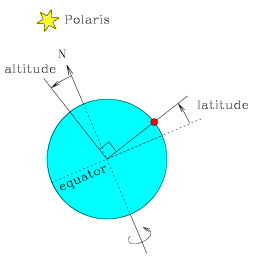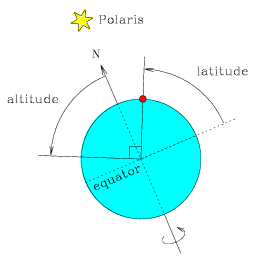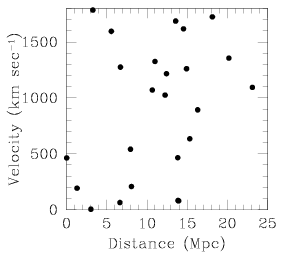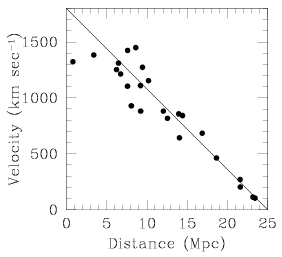

Summary of results:
Maria Mitchell's score on this quiz was 60% (any incorrect choices are highlighted in red).
#1. The diameter of the Sun is 1,392,000 kilometers, and the distance between the Earth and Sun is 150,000,000 kilometers. If you used a volleyball with an 8-inch diameter to represent the Sun, how far would you need to place it from your model Earth in a scale model of the solar system?
#2. If the North Star (Polaris) is located 58 degrees above the northern horizon, what is your latitude, in degrees?
#3. What force is responsible for the collapse of the giant gas cloud which formed our solar system?
#4. Einstein's theory of General Relativity tells us that time runs slower in the presence of a stronger gravitational field. This means that a clock left in which of the following locations would run the fastest?
#5. Which of the following plots best represents the type of data that Edwin Hubble plotted for nearby galaxies?
Elapsed Time: 4.36 minutes
#1.
The diameter of the Sun is 1,392,000 kilometers, and the distance between the Earth and Sun is 150,000,000 kilometers. If you used a volleyball with an 8-inch diameter to represent the Sun, how far would you need to place it from your model Earth in a scale model of the solar system?| 8.6 inches | 72 feet |
| 108 feet | 864 feet |
The Sun lies 150,000,000 / 1,392,000 = 150 / 1.392 = 108 times further away from the Earth than its own diameter. To reproduce this length in a model with an 8-inch diameter Sun, we would need to place it 8 inches × 108 = 864 inches = 72 feet away from our model Earth.


#2.
If the North Star (Polaris) is located 58 degrees above the northern horizon, what is your latitude, in degrees?Write your answer in the box, using a standard format for numbers. For example, if your answer is 16 degrees type "16" or "1.6e1".
Polaris is the North Star, located above the North Pole along the north celestial pole. When viewed from the equator it lies on the northern horizon (at an altitude of 0 degrees), and when viewed from the North Pole it lies directly overhead (at an altitude of 90 degrees). The closer the observer is to the North Pole, the higher Polaris appears in the sky.
The observers latitude is in fact exactly equal to the altitude of Polaris.
The two figures below show an observer located at a latitude of +15 degrees (left) and at +65 degrees (right). The blue globe represents the Earth, with the North Pole and equator labeled. The North Star, Polaris, lies high above the North Pole. The red dot indicates the position of the observer, and her latitude is the number of degrees she is located above the equator.
On the left, the observer's latitude is only 15 degrees above the equator. If the observer starts at the equator and moves north by 15 degrees, she will notice that Polaris is initially located on the northern horizon, and slowly shifts upward in the sky by 15 degrees (its altitude).
On the right, we shift the observer further north by an additional 50 degrees. The change in her position causes Polaris to rise even higher in the sky, because she has shifted northward and is thus moving closer to a position underneath it. In both cases, the altitude of Polaris is equal to the observer's latitude.
 |
 |


#3.
What force is responsible for the collapse of the giant gas cloud which formed our solar system?| strong (nuclear) force | pressure |
| gravity | the forceful personality of the Sun |
The gravitational attraction of the various particles in the solar nebulae, the gas cloud that eventually became our solar system, caused the collapse and the formation of the Sun and planets.


#4.
Einstein's theory of General Relativity tells us that time runs slower in the presence of a stronger gravitational field. This means that a clock left in which of the following locations would run the fastest?| the event horizon of a black hole | empty space |
| the surface of a neutron star | the surface of a white dwarf |
The theory of General Relativity predicts that strong gravity makes time run slower.
This means that if we took two clocks and placed one of them in a strong gravitational field (like that near a black hole, for a large effect), we would see the clocks run at different rates. The clock under the influence of stronger gravity would actually run slower than the other clock. Time runs faster near less massive objects, and so the clock left in empty space would run the fastest.
Among other things, this informs us that there is no master clock for the Universe, keeping perfect, absolute time. Time is in fact a relative quantity, and its passage can vary with environment.


#5.
Which of the following plots best represents the type of data that Edwin Hubble plotted for nearby galaxies?| Figure A | Figure B | Figure C |
| Figure A | Figure B | Figure C |
|---|---|---|
 |
 |
 |
Hubble plotted galaxy recessional velocities as a function of galaxy distances, finding a clear correlation (as the distance to a galaxy increases, so does its observed velocity).
One of these plots shows velocity decreasing with distance, and another shows no correlation between velocity and distance (the points are distributed randomly). Only one (Figure B) shows that as distance increases, so does velocity.

